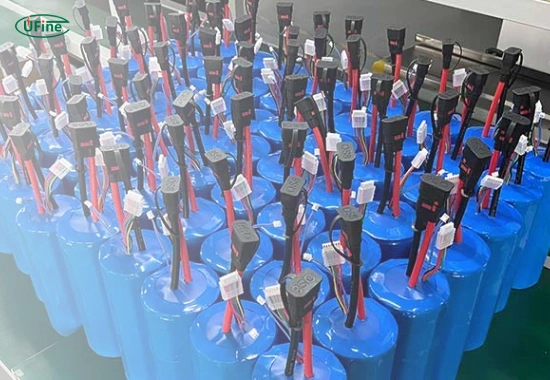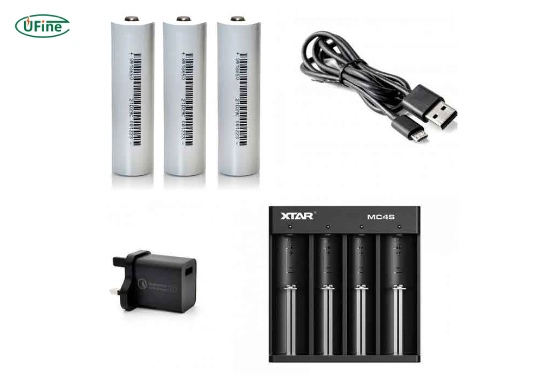The world of 18650 battery chargers encompasses many options, making the selection process both crucial and intricate. Understanding the nuances of these chargers is pivotal for optimal battery performance and safety. This article dives deep into the considerations, types, and charging methods to guide readers toward informed decisions when choosing an 18650 battery charger.
Part 1. Types of 18650 battery charger
Single-Bay Chargers
These chargers are simple and perfect for individual users needing to charge one battery at a time. While they lack multi-bay efficiency, they often come with basic safety features and are portable. Advanced single-bay chargers might integrate LCD screens to display charging status or voltage readings.
Multi-Bay Chargers
Ranging from dual-bay to eight-bay configurations, these chargers cater to users handling multiple batteries simultaneously. They vary in sophistication, with some models offering independent charging slots with individual progress monitoring, giving users greater control and efficiency.
Smart Chargers
With intelligent charging features, these chargers can identify battery types and adjust charging parameters accordingly. They often include safety measures like overcharge protection, reverse polarity detection, and temperature control. Advanced smart chargers might incorporate battery conditioning or diagnostic functions, ensuring optimal battery health.
USB-Powered Chargers
Compact and versatile, these chargers offer portability by drawing power from USB sources like laptops, power banks, or car adapters. They are favored for convenience during travel or when users require charging solutions in diverse settings. Some models come with multiple USB ports for charging several batteries simultaneously.
Fast Chargers
These chargers prioritize speed, employing technologies like Quick Charge or USB Power Delivery to reduce charging times significantly. However, while they offer rapid charging, users should be cautious about potential effects on battery lifespan and long-term health due to increased heat generation during faster charging.
Universal Chargers
Offering versatility, these chargers accommodate various battery sizes and types beyond the 18650s. They cater to a wide range of rechargeable batteries like AA, AAA, C, D, and others, providing users with a single charging solution for multiple battery types.
DIY Chargers
These chargers cater to enthusiasts or professionals seeking customization options. DIY kits or components allow users to modify charging parameters, build chargers tailored to specific needs, or conduct battery charging and management experiments.
Part 2. Note for buying 18650 battery charger
Selecting the ideal 18650 battery charger involves several key factors. Considering the charging speed, compatibility with various battery types, safety features like overcharge protection, and the charger’s overall build quality is essential. Users should also assess their specific needs, such as portability or advanced functionalities like LCDs or multiple charging slots.
Compatibility with 18650 Batteries
Ensure that the charger is specifically designed for 18650 batteries. Check compatibility regarding size and supporting various chemistries such as lithium-ion or lithium-polymer. Compatibility ensures proper charging and prevents damage to the batteries.
Safety Features
Prioritize chargers equipped with safety mechanisms. Look for overcharge protection, short-circuit prevention, and temperature regulation features. Certifications like CE, UL, or FCC compliance often indicate adherence to safety standards.
Charging Speed and Modes
Assess the charger’s charging speed and modes. Some chargers offer variable charging rates (0.5A, 1A, 2A, etc.) to accommodate different battery capacities and charging requirements. Fast-charging capabilities might be advantageous, but consider the impact on battery lifespan.
Number of Charging Bays
Determine the number of batteries you intend to charge simultaneously. Single-bay chargers are suitable for individual users, while multi-bay chargers are ideal for handling multiple batteries concurrently.
Portability and Versatility
If portability is a priority, opt for compact chargers or those with USB compatibility. Assess whether the charger suits various environments, such as travel or outdoor settings.
User-Friendly Features
Consider additional features that enhance user experience, such as LCD screens displaying charging status, intuitive interfaces, or indicators for battery health. These features contribute to convenience and ease of use.
Build Quality and Durability
When assessing build quality and durability in an 18650 battery charger, prioritize materials like high-grade ABS plastics or aluminum alloys. For instance, chargers constructed with reinforced ABS plastics offer excellent impact resistance and durability, ensuring prolonged usage without compromising safety. Additionally, aluminum alloy casings provide superior heat dissipation and sturdiness, contributing to the charger’s long-term reliability.
Part 3. How to charge 18650 battery?
Select a Compatible Charger: Choose a charger specifically designed for 18650 batteries. Ensure it supports the correct voltage and charging current suitable for these batteries to avoid damage or reduced lifespan.
Inspect Battery Condition:
- Before charging, check the condition of the 18650 batteries.
- Look for any signs of damage, leaks, or deformities.
- Avoid charging damaged batteries to prevent safety hazards.
Insert Batteries Correctly: Properly insert the 18650 batteries into the charger. Align the positive (+) and negative (-) terminals according to the charger’s indications or markings to ensure a secure connection.
Charging Mode Selection: Some chargers offer multiple charging modes (e.g., 0.5A, 1A, 2A). Choose the appropriate charging rate based on the battery’s capacity and the charger’s specifications. Slower charging rates can prolong battery lifespan.
Monitor Charging Progress: Regularly monitor the charging process. Most chargers have indicators, LED lights, or displays showing charging status. Remove batteries once fully charged to prevent overcharging.
Avoid Unattended Charging: Do not leave batteries unattended while charging. This precaution ensures immediate action in case of abnormalities, preventing hazards like overheating or short-circuiting.
Charge in a Suitable Environment: Charge 18650 batteries in a well-ventilated and non-flammable area. Avoid extreme temperatures or exposure to direct sunlight during the charging process.
Follow Manufacturer Guidelines: Adhere to the manufacturer’s recommendations and instructions regarding charging times, safety precautions, and compatibility. This ensures optimal performance and safety.
Storage after Charging: Once charged, store the 18650 batteries appropriately. Consider using protective cases or insulating materials to prevent accidental short-circuiting or damage during storage.
Regular Maintenance: Inspect and clean the charger’s terminals and contacts to maintain proper functionality. Remove any debris or dust accumulation that might hinder charging efficiency.
Part 4. FAQs
-
How do you charge an 18650 battery without a charger?
Charging without a dedicated charger can be risky and is not recommended. Using specialized chargers designed for 18650 batteries is the safest and most efficient method. -
How long does it take to charge an 18650 battery?
Charging time varies based on the charger’s current output and the battery’s capacity. Typically, it can take several hours to charge an 18650 battery fully. -
Can I charge an 18650 battery with an AA charger?
Charging an 18650 battery with a charger meant for AA batteries is not recommended. The charging requirements and voltages might differ, leading to potential safety hazards. -
Can you charge 18650 batteries with USB?
Yes, specialized USB chargers are available for 18650 batteries. A proper USB charger designed for 18650 cells ensures safe and efficient charging. -
How do you charge an 18650 battery pack with BMS?
Charging an 18650 battery pack with a Battery Management System (BMS) involves connecting the BMS to a suitable charger and ensuring that the BMS regulates the charging process, balancing individual cell voltages for safety and longevity.
Related Tags:
More Articles

How to Choose the Best Floor Scrubber Battery for Commercial Cleaning?
Selecting the ideal floor scrubber battery ensures a long runtime, rapid charging, and minimal maintenance for efficient commercial cleaning operations.
Battery for Blower vs Battery for Leaf Vacuum: Which One Should You Choose?
Battery for blower vs leaf vacuum—learn the key differences in power, fit, and runtime to choose the right battery for your outdoor tool needs.
How to Choose the Right Battery for Blower?
Choosing the right blower battery? Consider voltage, capacity, chemistry & usage. This guide helps match the best battery for peak performance.
How to Choose the Best Insulated Battery Box for Lithium Batteries?
Choosing the Best Insulated Battery Box for Lithium Batteries? Discover key factors such as size, material, and safety for optimal protection and performance.
7 Critical Elements on a Lithium Battery Shipping Label
What must be on a lithium battery shipping label? Learn 7 key elements to ensure safety, legal compliance, and correct handling across all transport modes.





